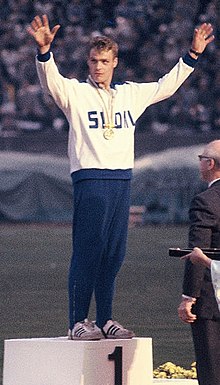Pauli Nevala
 Pauli Nevala at the 1964 Olympics | |
| Personal information | |
|---|---|
| Full name | Pauli Lauri Nevala |
| Born | 30 November 1940 (age 83) Pohja, Finland |
| Height | 1.77 m (5 ft 10 in) |
| Weight | 78–88 kg (172–194 lb) |
| Sport | |
| Sport | Javelin throw |
| Club | Teuvan Rivakka, Teuva |
Medal record | |
Pauli Lauri Nevala (born 30 November 1940) is a Finnish former javelin thrower.[1]
His first major international meet was the 1962 European Athletics Championships in Belgrade, where he went out in the qualification round. The next year saw him step up to the very upper echelon of javelin throwers with his new personal best (and national record) of 86.33 meters, thrown in Helsinki on 16 July 1963. This was very close to the world record at the time (86.74 m).
In the Olympic year 1964 however, Nevala had major problems even breaking 80 meters and did not enter the Tokyo Olympics as a favorite. He cleared the Olympic qualification quite easily while the world record holder, Terje Pedersen of Norway, was knocked out – the first man not to qualify. In the final Nevala threw confidently from the start, and took the lead with his fourth throw of 82.66 m,[2] his best that year. This was eventually enough for a victory, narrowly ahead of Gergely Kulcsár.[1]
After the Olympics Nevala's career stagnated. He finished fourth at the 1966 European Athletics Championships at Budapest. His attempt to defend his Olympic title at the 1968 Summer Olympics was cut short in the qualification as his longest throw was controversially declared flat and he failed to advance to the final.[3]
In 1969 Nevala's career had a major resurgence, as he finally broke his six-year-old personal best multiple times, culminating in a 91.40 m throw in his home town of Teuva. At the 1969 European Championships Nevala took the silver medal behind Jānis Lūsis of the Soviet Union. Nevala has later openly attributed this resurgence to anabolic steroids, which were not yet forbidden at the time.[3]
In 1970, Nevala was arguably the best javelin thrower in the world winning 50 out of his 55 competitions. He threw over 90 meters in 5 competitions, over 85 meters in 32 competitions and over 80 meters in 52 competitions. His top 10 average of the season was 90.12 m and all-season average 85.86 m. Nevala's personal best of 92.64 m in Helsinki on 6 September 1970 landed only 6 cm short of Jorma Kinnunen’s world record. In addition to the world's best performance of the year, Nevala was ranked number one javelin thrower by Track & Field News.[4][5]
Nevala and Kinnunen intentionally fouled all their qualification throws at the 1970 Finnish Championships as a protest against the Finnish Amateur Athletic Association. The protest eventually led to an improved stipend system.[6]
Nevala's career suddenly ended in April 1971 when, in his very first competition of the year at Abidjan, Côte d'Ivoire, he injured his shoulder so badly he could never throw seriously again.[3]
References
[edit]- ^ a b Pauli Nevala. sports-reference.com
- ^ "Athletics at the 1964 Tokyo Summer Games: Men's Javelin Throw Final Round". Sports Reference LLC. Archived from the original on 17 April 2020. Retrieved 6 November 2009.
- ^ a b c Kaarninen, Pekka (2003). Murheilua eli Suomen sinivalkoiset kyyneleet (in Finnish). WSOY. ISBN 951-0-27895-5.
- ^ "Pauli Nevala's competitions 1960–1971". Retrieved 9 July 2014.
- ^ "Track & Field News world rankings" (PDF). Retrieved 22 July 2014.[permanent dead link]
- ^ "Finnish Amateur Athletic Association 100 years – Pauli Nevala". Archived from the original on 11 July 2014. Retrieved 9 July 2014.
Text is available under the CC BY-SA 4.0 license; additional terms may apply.
Images, videos and audio are available under their respective licenses.
